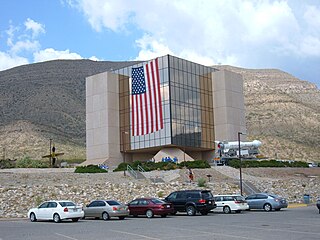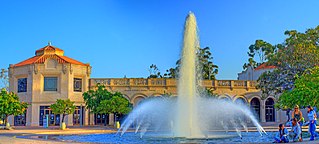
Shirley Ann Jackson, is an American physicist, and was the 18th president of Rensselaer Polytechnic Institute. She is the first African-American woman to have earned a doctorate at the Massachusetts Institute of Technology (MIT). She is also the second African-American woman in the United States to earn a doctorate in physics.

IMAX is a proprietary system of high-resolution cameras, film formats, film projectors, and theaters known for having very large screens with a tall aspect ratio and steep stadium seating.

Rensselaer Polytechnic Institute (RPI) is a private research university in Troy, New York, with an additional campus in Hartford, Connecticut. A third campus in Groton, Connecticut closed in 2018. RPI was established in 1824 by Stephen Van Rensselaer and Amos Eaton for the "application of science to the common purposes of life" and is the oldest technological university in the English-speaking world and the Western Hemisphere.

The New Mexico Museum of Space History is a museum and planetarium complex in Alamogordo, New Mexico dedicated to artifacts and displays related to space flight and the Space Age. It includes the International Space Hall of Fame. The Museum of Space History highlights the role that New Mexico has had in the U. S. space program, and is one of eight museums administered by the New Mexico Department of Cultural Affairs. The museum has been accredited by American Alliance of Museums since 1993. The museum is also a Smithsonian Affiliate.

We The Curious is a science and arts centre and educational charity in Bristol, England. It features over 250 interactive exhibits over two floors, and members of the public and school groups can also engage with the Live Science Team over programming in the kitchen, studio and on live lab. We The Curious is also home of the United Kingdom's first 3D planetarium. The centre describes its aim as being "to create a culture of curiosity".
Donna J. Cox is an American artist and scientist, Michael Aiken Endowed Chair; Professor of Art + Design; Director, Advanced Visualization Lab at the University of Illinois at Urbana-Champaign (UIUC); Director, Visualization and Experimental Technologies at National Center for Supercomputing Applications (NCSA); and Director, edream. She is a recognized pioneer in computer art and scientific visualization, specifically cinematic scientific visualization.

Adventure Thru Inner Space was an attraction in Disneyland's Tomorrowland, presented by Monsanto Company. It was the first attraction to utilize Disney's Omnimover system. The ride simulated shrinking guests to the size smaller than an atom before taking a tour of snowflakes at molecular and atomic levels.

The Fleet Science Center is a science museum and planetarium in Balboa Park, located in San Diego, California. It is at the east end of the El Prado Drive walkway, next to the Bea Evenson Fountain and plaza in central Balboa Park.

Telus World of Science Edmonton (TWOSE) is a broad-based science centre in Edmonton, Alberta, Canada, operated by the (non-profit) Edmonton Space & Science Foundation. The centre is located on the southwest corner of Coronation Park in the neighborhood of Woodcroft. The science centre houses 144,430 sq. ft. of public space and is the largest science centre in Western Canada. It is currently a member of both the Association of Science-Technology Centers (ASTC) and the Canadian Association of Science Centres (CASC).
Deborah Louise McGuinness is an American computer scientist and researcher at Rensselaer Polytechnic Institute (RPI). She is a professor of Computer, Cognitive and Web Sciences, Industrial and Systems Engineering, and an endowed chair in the Tetherless World Constellation, a multidisciplinary research institution within RPI that focuses on the study of theories, methods and applications of the World Wide Web. Her fields of expertise include interdisciplinary data integration, artificial intelligence, specifically in knowledge representation and reasoning, description logics, the semantic web, explanation, and trust.

The Houston Museum of Natural Science is a natural history museum located on the northern border of Hermann Park in Houston, Texas, United States. The museum was established in 1909 by the Houston Museum and Scientific Society, an organization whose goals were to provide a free institution for the people of Houston focusing on education and science. Museum attendance totals over two million visitors each year. The museum complex consists of a central facility with four floors of natural science halls and exhibits, the Burke Baker Planetarium, the Cockrell Butterfly Center, and the Wortham Giant Screen Theatre. The museum is one of the most popular in the United States and ranks just below New York City's American Museum of Natural History and Metropolitan Museum of Art and the M. H. de Young Memorial Museum in San Francisco in most attendance amongst non-Smithsonian museums. Much of the museum's popularity is attributed to its large number of special or guest exhibits.
Stephen Low is a Canadian film director and screenwriter who works extensively in the IMAX and IMAX 3D film formats. Based in Montreal, Quebec, over his 30-plus year career Low has directed numerous award-winning film documentaries including Challenger: An Industrial Romance (1980), Beavers (1988), Titanica (1991), Super Speedway (1997), Volcanoes of the Deep Sea (2003), Fighter Pilot: Operation Red Flag (2004), Ultimate Wave Tahiti 3D (2010), Legends of Flight 3D (2010), Rescue 3D (2011), Rocky Mountain Express (2011) and Aircraft Carrier (2017).
MacGillivray Freeman Films is an American film studio based in Laguna Beach, California and founded in the mid-1960s by Greg MacGillivray and Jim Freeman. It produces documentaries, feature films, and IMAX films.
Alec Lorimore is a twice Academy Award-nominated film producer and screenwriter who has concentrated his focus in creating giant screen, IMAX documentary films. He is credited as one of the three producers of 1998 IMAX film Everest, which had generated over $140 million in worldwide box office, making it the highest grossing IMAX documentary film.
James Lawson Neihouse is an American cinematographer who has been involved with many of the most memorable and successful IMAX 2D and IMAX 3D films to date.
Jordi Llompart Mallorquès is a Spanish journalist and film producer, director and writer. He directed and presented many Radio and TV shows, mainly as anchorman on news, and he also produced and directed several films and documentary series for cinema and television including innovative projects for IMAX and stereoscopic 3D cinema.

V. Owen Bush is a Canadian designer, producer, and filmmaker who uses immersion and participation to create transformative social experiences. His works have been seen worldwide in venues such as digital planetariums, live concerts and events, IMAX 3D, broadcast television, mobile devices, and the web.

Flight of the Butterflies is a 2012 Canadian documentary film directed and co-written by Mike Slee for 3D IMAX, starring Megan Follows, Gordon Pinsent, and Shaun Benson. The film covers Dr. Fred Urquhart's nearly 40-year-long scientific investigation into the monarch butterfly, tracking the details of what is considered one of the longest known insect migrations: the flight of the monarch butterfly from Central Mexico to the United States and Canada and back.

In Saturn's Rings is a large format movie about Saturn made exclusively from real photographs taken by spacecraft. Director Stephen van Vuuren used more than 7.5 million photographs and numerous film techniques to create the effect of flying through space around Saturn and among its rings. CGI and 3-D modeling were not used in any capacity to create the realistic feel van Vuuren wanted for the viewer's experience. Most of the photos were taken by various major space missions.
Linda Sue Schadler is the Dean of the College of Engineering and Mathematical Sciences at the University of Vermont. Her research investigates the mechanical, optical and electric behaviour of polymer composites. She is a Fellow of the Materials Research Society and ASM International.











